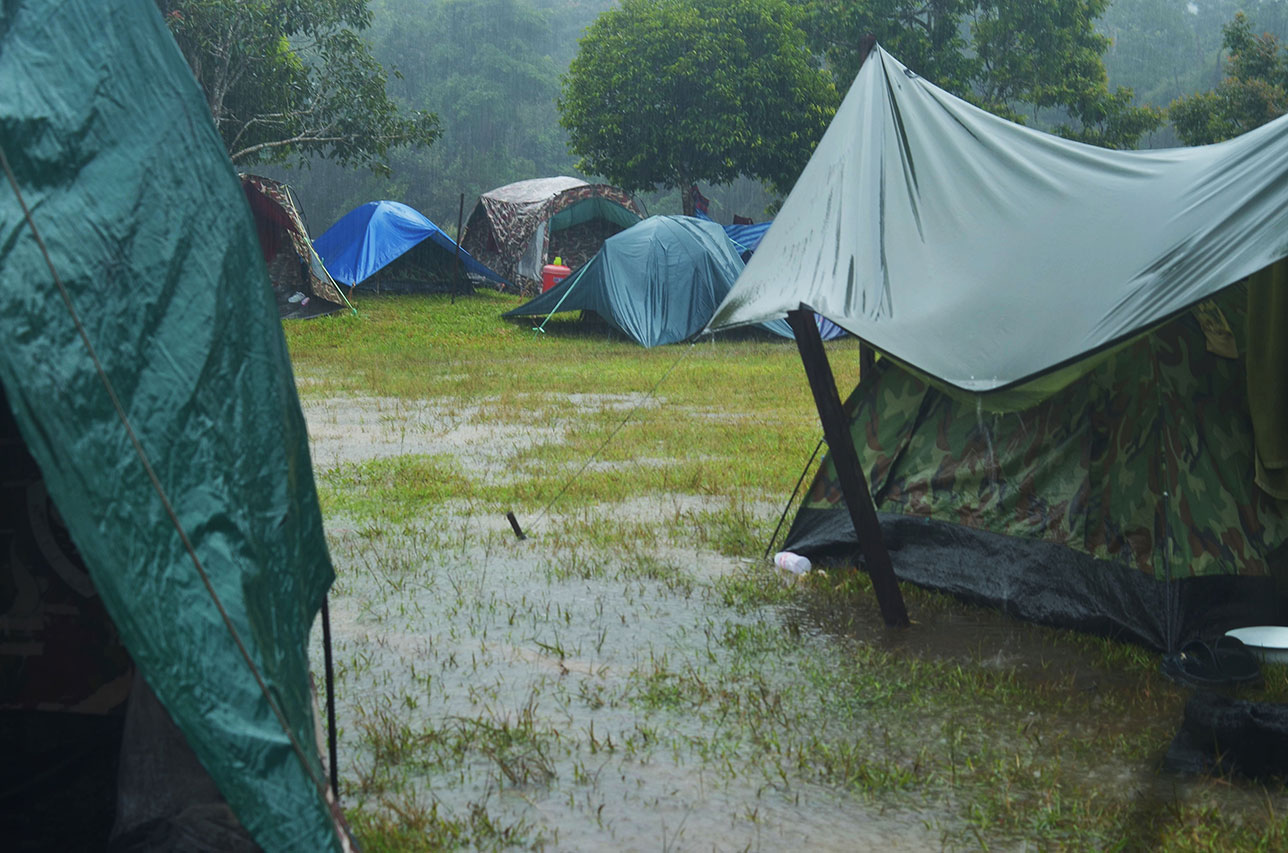
Water coming up through the sewn-in groundsheet is a rare occurrence in a family tent but it can happen if the conditions are right, or due to poor pitching or user error.
If this experience has happened to you - the chances are your tent is actually fine, and waterproof, but water has managed to break through the groundsheet due to pressure - it is important to remember that a tent is a piece of fabric, which is treated to be waterproof - enough water pressure will exceed the levels the tent is designed to keep out, and eventually, the fabric will begin to "perspire".
If your tent is a little older, it may be that the waterproof protection has diminished, and it might be time to reproof and treat the tent with a waterproofing agent.
This blog post aims to show the reasons why such an incident can take place, and why water will come up through the groundsheet in the right scenarios.
Groundsheets
The groundsheet of your tent is usually waterproof to a minimum of 5000mm (for lighter-weight tents), but in most cases, the basic waterproofing level for a tent groundsheet for the average tent is 10,000mm, which is a high level if tested normally by a hydrostatic head testing device.
However, a groundsheet is different in terms of waterproofing, as you have to realise a groundsheet is subjected to more pressure than a flysheet, as it is usually trapped against the ground. A flysheet is against the open air, so when it rains, the water will bead off and run down the sides of the tent and disperse into the ground. The same is not true of the groundsheet, as it is against the pressure of the ground. Therefore, you will always find, the groundsheet has a higher Hydrostatic Head than the flysheet, as it is treated to a higher waterproofing level.
Using a Footprint Groundsheet
Firstly, it is worth noting, this is one of the key reasons a footprint groundsheet exists for family tents, is to help protect the family tent from the elements, and keep the living space a dry place. However, on rare occasions, there is a chance water can come up through the groundsheet.
Why does this happen?
Not using a groundsheet protector or a footprint groundsheet underneath your tent.
If you do not use the groundsheet under the tent, then the tent has no protection from below other than the sewn-in groundsheet, or the perimeter groundsheet the tent comes with. Tents of yesteryear had larger, heavier groundsheets, but modern tents are designed to be lighter in weight, and as a result, the modern groundsheet is not as thick or as waterproof as it used to be.
Now, it may be a perfectly reasonable scenario to not use a footprint, but essentially if you are camping on boggy and wet ground, then there is every chance that water will come upwards through the tent groundsheet, because the pressure from the inside of the tent, from a person laying on a mattress, or the weight of your belongings, can put pressure on the internal groundsheet, which then in boggy conditions can force the water upwards into your tent if the water table is high.
Pitching onto a footprint is a great option, because it gives you a clean, dry base to pitch on, and gives two layers of protection against the elements. Also, your tent will be clean at the end of your trip.
Ill-fitting Footprint Groundsheets
If a footprint is not the right match for a tent in terms of shape and size, for example, it is too big, then it might overlap the actual tent, leading to water being able to get between the two groundsheets, which will cause water to potentially rise up through the tent groundsheet.
Again the same scenario if the groundsheet is far too small for the tent, you might find that the sewn-in groundsheet is then exposed to boggy conditions.
Water trapped between the groundsheet and the footprint: (Rain when Pitching)
This can happen if it is raining during the pitching, that water will get onto the footprint groundsheet, and then the tent is pitched on top of the footprint. The pressure between the two layers, and any weight applied inside the tent, will force the water upwards through the tent groundsheet’s fabric fibres, this is a simple matter of pressure, as the water is trapped on the footprint, and cannot disperse into the ground.
Camping on a slope / uneven ground:
Once more, the water can run down between the layers of the groundsheets, causing the same issue as above. Water between groundsheet layers is a rookie mistake, and in most cases, I would expect the water to rise through the groundsheet, as it cannot escape easily into the ground, and the internal pressure of equipment and people inside the tent will create pressure between the two groundsheets.
High Water Table:
If the ground is completely saturated, boggy, and essentially flooded under your feet, then the water has nowhere to go, and it will rise up through the tent groundsheets, it is a matter of pressure and time for it to soak through the groundsheet fibres.
Age of the tent:
In some instances, it could just be your tent is ready for a coat of waterproofing, and the groundsheets need reproofing. A tent should be retreated every 12-24 months, depending on usage.
How can you prevent this from happening:
- Treat and re-proof your tent every 12-24 months
- Make sure you use a footprint groundsheet in all occasions to protect the tent’s groundsheet and lengthen the lifetime of the tent.
- Ensure the base groundsheet is completely dry before pitching the tent on top.
- Avoid lower ground or boggy weather conditions.
